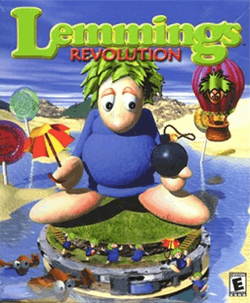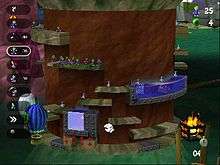Lemmings Revolution
| Lemmings Revolution | |
|---|---|
 | |
| Developer(s) | Take-Two Interactive |
| Publisher(s) | Psygnosis, Talonsoft |
| Platform(s) | Microsoft Windows |
| Release |
|
| Genre(s) | Puzzle |
| Mode(s) | Single-player |
Lemmings Revolution is a puzzle video game released in 2000. Like previous games in the Lemmings series, the object of the game is to guide the lemmings characters to an exit by giving them specific skills. Each level is situated on a rotating cylinder (the "revolution" of the title), so while the game is displayed in 3D, it plays much more like the 2D games.
Storyline
The storyline of Lemmings Revolution revolves around Weasel characters that once entertained themselves by watching the old adventures of the lemmings. Wanting more, they have captured the lemmings and created new puzzles, so they can watch the lemmings.
Gameplay

The main new element in this game is the change of the level design. All levels now consist of cylindrical columns, causing the lemmings to walk in large circles on the outer-most area. This essentially creates 2D levels that simply wrap around a cylinder from one side to the other. The levels no longer have an end at left or right, giving lemmings the ability to return to a location without retracing their route when encountering an obstacle. This whole concept was first shown in 8-bit era game Nebulus, one of the most famous platform games for the Commodore 64 and other contemporary computers.
The levels are viewed from a single point, from which the player can rotate the level on its axis in either direction. This is similar to simply scrolling left or right in the original games. Zooming in and out is also possible at one single step. In zoomed mode is possible to move the camera at a fixed angle. All original eight skills from Lemmings return in this game, with the same usage. Also returning from previous games are the fast-forward button and the "nuke all" option. The level structure has also changed significantly. Once a level has been completed, two more levels become available, each slightly more difficult than the previous one. This creates a hierarchal, triangular structure, allowing more and more levels to become available as the game progresses. In this way it is possible to play through to the final column of levels while skipping some others. There are 102 levels in total.
Reception
The game has received average to positive reviews from the game critics. The highest score was 8/10, given by IGN[1] and the critics PC Gameplay, Game Raiders, Computer Games Mag and Computer Games World.[2] The lowest score was 30/100 given by Frictionless Insight.[3]
References
- ↑ IGN Review of Lemmings Revolution Archived 2012-08-10 at the Wayback Machine. by Scott Steinberg, Retrieved May 26, 2000
- ↑ Lemmings Revolution for PC at Gamerankings Archived 2010-09-01 at the Wayback Machine.
- ↑ Frictionless Insight Review of Lemmings Revolution Archived 2012-03-20 at the Wayback Machine.